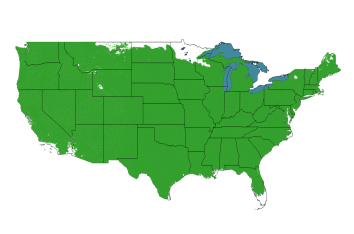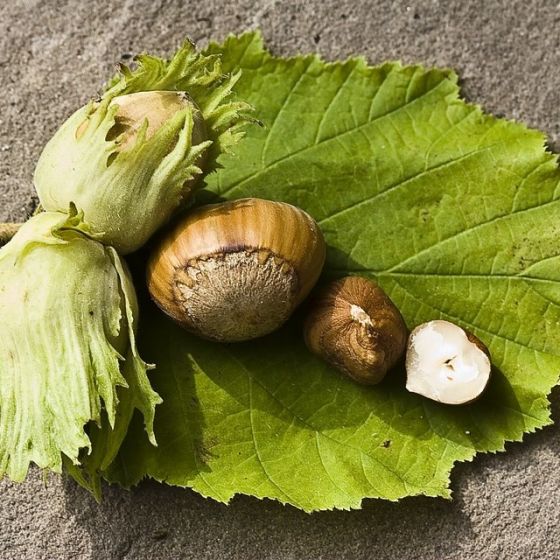✖
Cash Crop Nuts Attractive Native Hazelnut Shrub
- American Native Hazelnut
- Pollinator to Hybrid Hazelnuts, or Hazelberts
- Disease Resistant
- Cold Hardy
- Unshelled Nuts Keep for Over a Year
- Easy to Shell with a Simple Crack
- Heart Healthy Hazelnuts a Rich Source of Oleic Acid
- Worldwide Interest Growing in this Valuable Cash Crop
- Delicious Edible Nuts Used by Candymakers Worldwide
- Excellent Large Landscape Shrub
- Gorgeous Fall Color
- Fast-Growing Privacy Screen
- Naturalize for Use in a Food Forest
- Grows in Almost Any Condition
Hazelnut (Corylus Americana) is an excellent, larger, native shrub which can be used in more naturalized areas for windbreaks. Try it as a perfect freeform screening plant with benefits.
American Hazelnut is one of the best species of the native Oak savannah. It is a classic addition to edible landscapes and will provide edible nuts in the fall.
This remarkable plant can grow almost anywhere. It quickly grows to its mature size.
Filberts or Hazelnut? Depends on the Variety
Both the American and the European varieties of common hazel plants produce edible nuts. But the European varieties (Corylus avellana) are also called Filberts.
We sell the American variety of Hazelnut, which is resistant to the "Eastern Filbert Blight." The European varieties are susceptible, and it's caused a lot of heartache.
However, researchers at Oregon State University have been very successful at grafting these European trees onto blight-resistant rootstock. European Filbert Nuts grow beautifully at orchards in Willamette Valley in Oregon. What a treat to visit there someday! (Don't forget to try their famed Pinot Noir!)
Efforts are also well underway to produce American/European hybrid plants. These have been very successful for Midwest growers. This plant will pollinate hybrid Hazelnuts, sometimes known as Hazelberts.
How to Use American Hazelnut in the Edible Landscape
American Hazelnut is a great shrub for the Midwest and East Coast. It handles cold and heat without missing a beat.
It's adaptable to wet or dry conditions, too. If you have the room, and want to encourage a sustainable landscape, or homestead - try the American Hazelnut.
Use in a Rain Garden or as a riparian buffer along a stream bed. It makes a fantastic woodland border.
It can grow in dry conditions, as well. Use them as a screen or to identify a property line. For the driest areas of Zone 9, give it protection from afternoon sun. Plan to provide supplemental water in extended periods of drought.
You really won't have to worry much about this shrub. Just watch how fast it grows to give you a lovely, airy sense of privacy. Plant American Hazelnuts where they can reach their full size without restriction.
If it gets too big? Just coppice it, by cutting all the branches off right at the soil line. Your plant will grow back from its roots. It will achieve a good size within 2 - 3 years.
Although they have both male and female flowers on the same plant, it is best to plant three or more for pollination. You'll want plenty to harvest.
In the spring, 3-inch clusters of male catkins appear, their yellow-brown tassels gently swaying in the warm breeze. These male catkins will pollinate the tiny female flowers.
Dark green, heart-shaped, 3-6-inch serrated leaves will soon fill out Hazelnut for summer. For a wonderful visual treat, the fall colors range from vivid orange, mellow gold and yellows and deepen into rich wine-reds.
In late summer and early fall, you'll notice green, leafy. clustered capsules appearing throughout the bush. Egg-shaped nuts are surrounded by ragged-edge bracts that eventually turning brown. When ripe, gently pop off the brown husk and you're ready for a treat.
There are many health benefits of hazelnuts as a snack. Raw hazelnuts, hazelnut oil, hazelnut butter or hazelnut flours are in high demand worldwide. This nut has a lot of heart healthy unsaturated fats and dietary fiber.
Hazelnuts are rich in vitamin E, manganese, thiamine, copper and are a delicious boost to Keto dieters when eaten as a snack.
Raw or roasted, the hazelnut is an outstanding nut. It's sweet in flavor and although having a variety of uses, is often used in desserts. It's rich in fiber, vitamins and minerals with the added benefit of being gluten-free for those who are sensitive. The oil is often used in medications and in aromatherapy.
American hazelnuts are perfect for baking and candy. Incorporate them into homemade energy bars, Keto fat bombs, granola, or hot cereal.
Roast hazelnuts and press into oil. You'll love cooking with this flavorful oil. Your cardiologist will be impressed with the 80% oleic acid, which is on par with olive oil.
This is a crop you don't replant. They'll just get better every year.
As a specialty food crop, they can provide a lucrative income. In-shell hazelnuts have high profit margins. Shelled raw hazelnuts retails even higher.
Per acre, hazelnuts are more valuable than corn. University of Nebraska is studying how this plant can be hybridized with the European varieties. The goal is to deliver a profitable new market for farmers across the United States.
Beyond food, the oil can be used as fuel. Hazelnuts can be grown anywhere from a large backyard to a large farm.
The worldwide market for hazelnuts looks bright. After all, Europeans eat even more hazelnuts than Americans do.
Why not trying hazelnut growing for yourself and your family?
You get an attractive, large, low maintenance shrub with lovely fall coloring. For a hardy shrub with a lot of appeal, you can't go wrong with a Hazelnut.
#ProPlantTips for Care
If you'll be growing Hazelnuts for production and sale, check the spread and density of the plant in fall to keep it healthy. Protect young plants for the first several years with chicken wire fencing.
Leave it be to grow as it will if you'll be naturalizing this screening plant. It's a wonderful choice to fill in bare areas.
For nuts, give it a regular renewal pruning by removing the oldest, fattest stems right down to the ground every 3 to 4 years. Allow the younger thinner stems to remain.
This method is best for nut production. Starting in year 5, select the thickest, oldest stems in fall or winter. Cut them off at ground level. Remove 1/3 of the oldest stems completely.
This will easily allow younger, more productive stems to produce their share of hazelnuts for your family or business. Over a 3 year cycle, you'll rejuvenate your entire shrub. For the best results, you'll want to plan on a renewal every 5 years or so.
For a natural look, plant them 6 feet apart on center. You'll measure from the center of one plant to the center of the next.
To maintain the trees as individual plants, increase the spacing to 12 feet apart. Stagger the rows in a zig-zag planting pattern to speed the time to achieve a screen.
If you don't get them first, the hazelnuts provide food mast and cover for birds like wild turkey, quail, woodpeckers, blue jays and pheasants. Ruffled grouse love to feast on the male catkins.
What a magnificent American treasure. Order your Hazelnut from LetsPlantify.com today!
| Botanical Name | Corylus americana |
|---|---|
| Mature Height | 8 - 15 feet |
| Mature Spread | 8 - 15 feet |
| Soil Type | Widely Adaptable |
| Moisture | Moderate |
| Sun Exposure | Full Sun, Partial Shade |
| Growth Rate | Fast |
| Bloom Period | Early Spring |
| Flower Color | Yellow |
| Foliage Color | Green |
| Fall Color | Yellow, Orange, Red |
| Fruiting Time | Mid Season |
| Pollinator Required | Yes |
| Pollinator Friendly | Yes |
| Growing Zone Range | 4-9 |

Write Your Own Review

